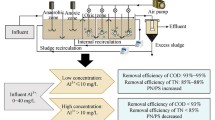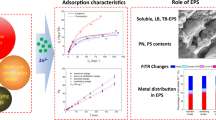Abstract
This study presents the role of extracellular polymeric substances (EPS) in reducing the inhibitory effects of copper towards nitrifying activated sludge. EPS could ameliorate copper toxicity in activated sludge by binding metal ions. A series of copper inhibition experiments were conducted with activated sludge taken from laboratoryscale sequencing batch reactor (SBR) systems operated under different feast-famine cycles, which provided the different conditions to the EPS-producing heterotrophic populations. The toxicity of copper to both nitrifiers and heterotrophs decreased with increasing the feast-famine period. Average EPS contents were substantially higher in SBR sludge with longer feast-famine periods indicating that the decrease in the toxicity of copper at a longer feastfamine period was attributed to the presence of higher amounts of EPS. Comparison of the responses of nitrifiers and heterotrophs to free copper suggests that nitrifiers were no more sensitive to copper than heterotrophs.
Similar content being viewed by others
References
Madoni, P., D. Davoli, and L. Guglielmi (1999) Response of sOUR and AUR to heavy metal contamination in activated sludge. Water Res. 33: 2459–2464.
Kelly, R. T., I. D. S. Henriques, and N. G. Love (2004) Chemical inhibition of nitrification in activated sludge. Biotechnol. Bioeng. 85: 683–694.
You, S. J., Y. P. Tasi, and R. Y. Huang (2009) Effect of heavy metals on nitrification performance in different activated sludge process. J. Hazard. Mater. 165: 987–994.
Lee, Y. W., S. K. Ong, and C. Sato (1997) Effects of heavy metals on nitrifying bacteria. Wat. Sci. Tech. 36: 69–74.
Hu, Z., K. Chandran, D. Grasso, and B. F. Smets (2004) Comparison of nitrification inhibition by metals in batch and continuous flow reactors. Water Res. 38: 3949–3959.
Burnat, M., E. Diestra, I. Esteve, and A. Sole (2009) In situ determination of the effects of lead and copper on cyanobacterial populations in microcosms. PLoS One 4: e6204.
Sun F. L., L. L. Fan, and G. J. Xie (2016) Effect of copper on the performance and bacterial communities of activated sludge using Illumina MiSeq platorms. Chemosphere 156: 212–219.
Kim, K.T., I. S. Kim, S. H. Hwang, and S. D. Kim (2006) Estimating the combined effects of copper and phenol to nitrifying bacteria in wastewater treatment plants. Water Res. 40: 561–568.
Zhou, X. H., T. Yu, H. C. Shi, and H. M. Shi (2011) Temporal and spatial inhibitory effects of zinc and copper on wastewater biofilms from oxygen concentration profiles determined by microelectrodes. Water Res. 45: 953–959.
Ochoa-Herrera, V., G. León, Q. Banihani, J. A. Field, and R. Sierra-Alvarez (2011) Toxicity of copper (II) ions to microorganisms in biological wastewater treatment systems. Sci. Total Environ. 412-413: 380–385.
Ouyang, F., H. Zhai, M. Ji, H. Zhang, and Z. Dong (2016) Physiological and transcriptional responses of nitrifying bacteria exposed to copper in activated sludge. J. Haz. Mat. 301: 172–178.
Rudd, T., R. M. Sterritt, and J. N. Lester (1984) Complexation of heavy metals by extracellular polymers in the activated sludge process. J. Water Pollut. Cont. Fed. 56: 1260–1268.
Sheng, G. P., J. Xu, H. W. Lou, W. W. Li, W. H. Li, H. Q. Yu, Z. Xie, S. Q. Wei, and F. C. Hu (2013) Thermodynamic analysis on the binding of heavy metals onto extracellular polymeric substances (EPS) of activated sludge. Water Res. 47: 607–614.
Principi, P., F. Villa, M. Bernasconi, and E. Zanardini (2006) Metal toxicity in municipal wastewater activated sludge investigated by multivariate analysis and in situ hybridization. Water Res. 40: 99–106.
Lawson, P. S., R. M. Sterritt, and J. N Lester (1984) Adsorption and complexation mechanisms of heavy metal uptake in activated sludge. J. Chem. Tech. Biotechnol. 34: 253–262.
Norberg, A. B. and H. Persson (1984) Accumulation of heavy-metal ions by Zoogloea ramigera. Biotechnol. Bioeng. 26: 239–246.
Su, M. C., D. K. Cha, and P. R. Anderson (1995) Influence of selector technology on heavy metal removal by activated sludge: Secondary effects of selector technology. Water Res. 29: 971–976.
Comte, S., G. Guibaud, and M. Baudu (2006) Biosorption properties of extracellular polymeric substances (EPS) resulting from activated sludge according to their type: Soluble or bound. Proc. Biochem. 41: 815–823.
Yuncu, B., F. D. Sanin, and U. Yetis (2006) An investigation of heavy metal biosorption in relation to C/N ratio of activated sludge. J. Hazard. Mater. 137: 990–997.
Larsen, P., J. L. Nielson, D. Otzen, and P. H. Nielsen (2008) Amyloid-like adhesins produced by floc-forming and filamentous bacteria in activated sludge. Appl. Environ. Microb. 74: 1517–1526.
Sag, Y. and T. Kutsal (1995) Biosorption of heavy metals by Zoogloea ramigera: use of adsorption isotherm and a comparison of biosorption characteristics. Chem. Eng. J. 60: 181–188.
Pereira, S., E. Micheletti, A. Zille, A. Santos, P. Moradas-Ferreira, P. Tamagnini, and R. De Philippis (2011) Using extracellular polymeric substances (EPS) producing cyanobacteria for the bioremediation of heavy metals: do cations compete for the EPS functional groups and also accumulate inside the cell? Microbiol. 157: 451–458.
Nouha, K., R. S. Kumar, and R. D. Tyagi (2016) Heavy metals removal from wastewater using extracellular polymeric substances produced by Cloacibacterium normanense in wastewater sludge supplemented with crude glycerol and study of extracellular polymeric substances extraction by different methods. Bioresour. Technol. 212: 120–129.
Friedman, B. A. and P. R. Dugan (1968) Identification of Zoogloea species and the relationship to Zoogloea matrix and floc formation. J. Biotechnol. 95: 1903–1909.
Cha, D. K. (1990) Process control factors influencing Nocardia population in activated sludge. Ph. D. Dissertation. University of California, Berkeley, USA.
van Niekerk, A. M., D. Jenkins, and M. G. Richard (1987) The competitive growth of Zoogloea ramigera and Type 021N in activated sludge and pure culture–a model for low F:M bulking. J. Water. Pollut. Cont. Fed. 59: 262–273.
Ozdemir, G., T. Ozturk, N. Ceyhan, R. Isler, and T. Cosar (2003) Heavy metal biosorption by biomass of Ochrobactrum anthropi producing exopolysaccharide in activated sludge. Bioresour. Technol. 90: 71–74.
Zhang, D., J. Wang, and X. Pan (2006) Cadmium sorption by EPSs produced by anaerobic sludge under sulfate-reducing conditions. J. Hazard. Mater. 138: 589–593.
Brown, M. J. and J. N. Lester (1980) Comparison of bacterial extracellular polymer extraction methods. Appl. Environ. Microb. 40: 179–185.
American Public Health Association (2005) Standard Methods for the Examination of Water and Wastewater. 21st ed., Washington DC, USA.
Wang, Z., L. Liu, J. Yao, and W. Cai (2006) Effects of extracellular polymeric substances on aerobic granulation in sequencing batch reactors. Chemosphere 63: 1728–1735.
Ni, B. J., B. E. Rittmann, F. Fang, J. Xu, and H. Q. Yu (2010) Long-term formation of microbial products in a sequencing batch reactor. Water Res. 44: 3787–3796.
Liu, Y., M. C. Lam, and H. H. P. Fang (2001) Adsorption of heavy metals by EPS of activated sludge. Water Sci. Technol. 43, 6, 59–66.
Ma, H., S. D. Kim, D. K. Cha, and H. E. Allen (1999) Effect of kinetics of complexation by humic acid on toxicity of copper to Ceriodaphnia dubia. Environ. Toxicol. Chem. 18: 828–837.
Kim, S. D., H. Ma, H. E. Allen, and D. K. Cha (1999) Influence of dissolved organic matter on the toxicity of copper to Ceriodaphnia dubia: Effect of complexation kinetics. Environ. Toxicol. Chem. 18: 2433–2437.
Author information
Authors and Affiliations
Corresponding author
Rights and permissions
About this article
Cite this article
Song, J.S., Maeng, M., Lee, K. et al. The role of extracellular polymeric substances in reducing copper inhibition to nitrification in activated sludge. Biotechnol Bioproc E 21, 683–688 (2016). https://doi.org/10.1007/s12257-016-0329-8
Received:
Revised:
Accepted:
Published:
Issue Date:
DOI: https://doi.org/10.1007/s12257-016-0329-8




